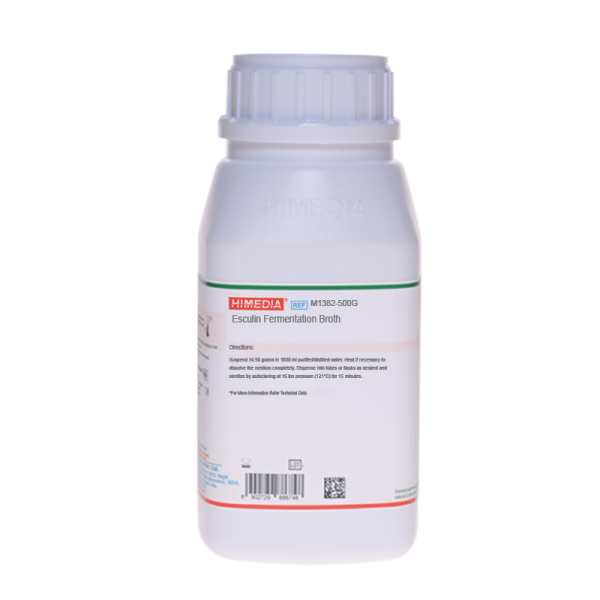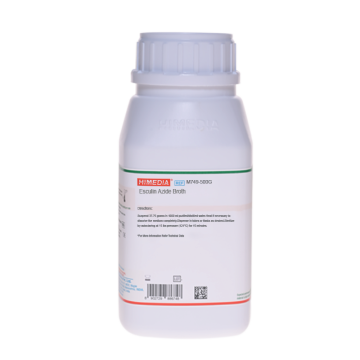 Your enquiry has been submitted
Your enquiry has been submitted
Esculin Fermentation Broth
Media for Testing Single Characteristics#CC293D
Intended Use
Recommended for cultivation and differentiation of bacteria which hydrolyze esculin.
Composition**
| Ingredients | Gms / Litre |
|---|---|
| HM infusion B from # | 500.000 |
| Tryptose | 10.000 |
| Sodium chloride | 5.000 |
| Esculin | 1.000 |
| Agar | 1.000 |
Final pH (at 25°C): 7.0±0.2
**Formula adjusted, standardized to suit performance parameters # Equivalent to Beef heart, infusion from
Directions
Suspend 34.50 grams in 1000 ml purified / distilled water. Heat if necessary to dissolve the medium completely. Dispense into tubes or flasks as desired. Sterilize by autoclaving at 15 lbs pressure (121°C) for 15 minutes.
Note: Esculin hydolysis is observed on addition of Ferric citrate 0.1 gm/litre
Principle And Interpretation
Esculin Fermentation Broth is used for cultivation and differentiation of bacteria which hydrolyze esculin (3). Tryptose and HM infusion B provide amino acids or other nitrogenous substances that support bacterial growth. Sodium chloride maintains osmotic equilibrium. Esculin is a glycoside incorporated as a differential agent to facilitate the identification of various organisms. Hydrolysis of esculin yields esculetin and dextrose.
Type of specimen
Isolated Microorganism
Specimen Collection and Handling
For samples follow appropriate techniques for handling specimens as per established guidelines (1,2). After use, contaminated materials must be sterilized by autoclaving before discarding.
Warning and Precautions :
Read the label before opening the container. Wear protective gloves/protective clothing/eye protection/ face protection. Follow good microbiological lab practices while handling specimens and culture. Standard precautions as per established guidelines should be followed while handling specimens. Safety guidelines may be referred in individual safety data sheets.
Limitations :
- Pure isolated colonies must be used for testing esculin hydrolysis.
Performance and Evaluation
Performance of the medium is expected when used as per the direction on the label within the expiry period when stored at recommended temperature.
Quality Control
Appearance: Cream to yellow homogeneous free flowing powder
Coloured and Clarity of prepared medium: Amber coloured clear to slightly opalescent with purplish tinge
Reaction: Reaction of 3.45% w/v aqueous solution at 25°C. pH : 7.0±0.2
Cultural Response
Cultural characteristics observed after an incubation at 35-37°C for 18-24 hours.
| Organism | Growth | Esculin hydrolysis |
|---|---|---|
| Escherichia coli ATCC 25922 (00013*) | good | Negative reaction |
| Enterococcus faecalis ATCC 29212 (00087*) | luxuriant | Positive reaction, blackening of medium |
| Enterococcus faecium ATCC 19434 (00010*) | luxuriant | Positive reaction, blackening of medium |
| Yersinia enterocolitica ATCC 27729 | luxuriant | Positive reaction, blackening of medium |
Key : (*) Corresponding WDCM numbers.
Storage and Shelf Life
Store between 10-30°C in a tightly closed container and the prepared medium at 15-25°C. Use before expiry date on the label. On opening, product should be properly stored dry, after tightly capping the bottle in order to prevent lump formation due to the hygroscopic nature of the product. Improper storage of the product may lead to lump formation. Store in dry ventilated area protected from extremes of temperature and sources of ignition. Seal the container tightly after use. Product performance is best if used within stated expiry period.
Disposal
User must ensure safe disposal by autoclaving and/or incineration of used or unusable preparations of this product. Follow established laboratory procedures in disposing of infectious materials and material that comes into contact with sample must be decontaminated and disposed of in accordance with current laboratory techniques (1,2).
Reference
- Isenberg, H.D. Clinical Microbiology Procedures Handbook 2nd Edition.
- Jorgensen, J.H., Pfaller, M.A., Carroll, K.C., Funke, G., Landry, M.L., Richter, S.S and Warnock., D.W. (2015) Manual of Clinical Microbiology, 11th Edition. Vol. 1.
- Shigei 1992, In Isenberg (ed.); Clinical microbiology procedures handbook, Vol-1, American Society for Microbiology, Washington, D.C.
| Product Name | Esculin Fermentation Broth |
|---|---|
| SKU | M1382 |
| Product Type | Regular |
| Physical Form | Powder |
| Origin | Animal |
| Packaging type | HDPE |
| References | 1.Shigei 1992, In Isenberg (ed.); Clinical microbiology procedures handbook, Vol-1, American Society for Microbiology,Washington, D.C. |
| Customized Product Available | No |





